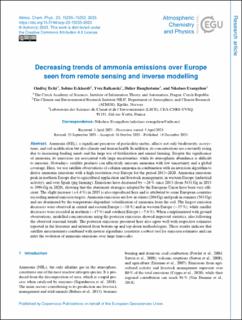| dc.contributor.author | Tichý, Ondřej | |
| dc.contributor.author | Eckhardt, Sabine | |
| dc.contributor.author | Balkanski, Yves | |
| dc.contributor.author | Hauglustaine, Didier | |
| dc.contributor.author | Evangeliou, Nikolaos | |
| dc.date.accessioned | 2024-01-16T07:45:45Z | |
| dc.date.available | 2024-01-16T07:45:45Z | |
| dc.date.created | 2024-01-08T14:02:34Z | |
| dc.date.issued | 2023 | |
| dc.identifier.citation | Atmospheric Chemistry and Physics (ACP). 2023, 23 (24), 15235-15252. | en_US |
| dc.identifier.issn | 1680-7316 | |
| dc.identifier.uri | https://hdl.handle.net/11250/3111639 | |
| dc.description.abstract | Ammonia (NH3), a significant precursor of particulate matter, affects not only biodiversity, ecosystems, and soil acidification but also climate and human health. In addition, its concentrations are constantly rising due to increasing feeding needs and the large use of fertilization and animal farming. Despite the significance of ammonia, its emissions are associated with large uncertainties, while its atmospheric abundance is difficult to measure. Nowadays, satellite products can effectively measure ammonia with low uncertainty and a global coverage. Here, we use satellite observations of column ammonia in combination with an inversion algorithm to derive ammonia emissions with a high resolution over Europe for the period 2013–2020. Ammonia emissions peak in northern Europe due to agricultural application and livestock management, in western Europe (industrial activity), and over Spain (pig farming). Emissions have decreased by −26 % since 2013 (from 5431 Gg in 2013 to 3994 Gg in 2020), showing that the abatement strategies adopted by the European Union have been very efficient. The slight increase (+4.4 %) in 2015 is also reproduced here and is attributed to some European countries exceeding annual emission targets. Ammonia emissions are low in winter (286 Gg) and peak in summer (563 Gg) and are dominated by the temperature-dependent volatilization of ammonia from the soil. The largest emission decreases were observed in central and eastern Europe (−38 %) and in western Europe (−37 %), while smaller decreases were recorded in northern (−17 %) and southern Europe (−7.6 %). When complemented with ground observations, modelled concentrations using the posterior emissions showed improved statistics, also following the observed seasonal trends. The posterior emissions presented here also agree well with respective estimates reported in the literature and inferred from bottom-up and top-down methodologies. These results indicate that satellite measurements combined with inverse algorithms constitute a robust tool for emission estimates and can infer the evolution of ammonia emissions over large timescales. | en_US |
| dc.language.iso | eng | en_US |
| dc.rights | Navngivelse 4.0 Internasjonal | * |
| dc.rights.uri | http://creativecommons.org/licenses/by/4.0/deed.no | * |
| dc.title | Decreasing trends of ammonia emissions over Europe seen from remote sensing and inverse modelling | en_US |
| dc.title.alternative | Decreasing trends of ammonia emissions over Europe seen from remote sensing and inverse modelling | en_US |
| dc.type | Peer reviewed | en_US |
| dc.type | Journal article | en_US |
| dc.description.version | publishedVersion | en_US |
| dc.rights.holder | © Author(s) 2023. | en_US |
| dc.source.pagenumber | 15235-15252 | en_US |
| dc.source.volume | 23 | en_US |
| dc.source.journal | Atmospheric Chemistry and Physics (ACP) | en_US |
| dc.source.issue | 24 | en_US |
| dc.identifier.doi | 10.5194/acp-23-15235-2023 | |
| dc.identifier.cristin | 2222398 | |
| dc.relation.project | Norges forskningsråd: 275407 | en_US |
| dc.relation.project | NILU: 118063 | en_US |
| cristin.ispublished | true | |
| cristin.fulltext | original | |
| cristin.qualitycode | 2 | |

